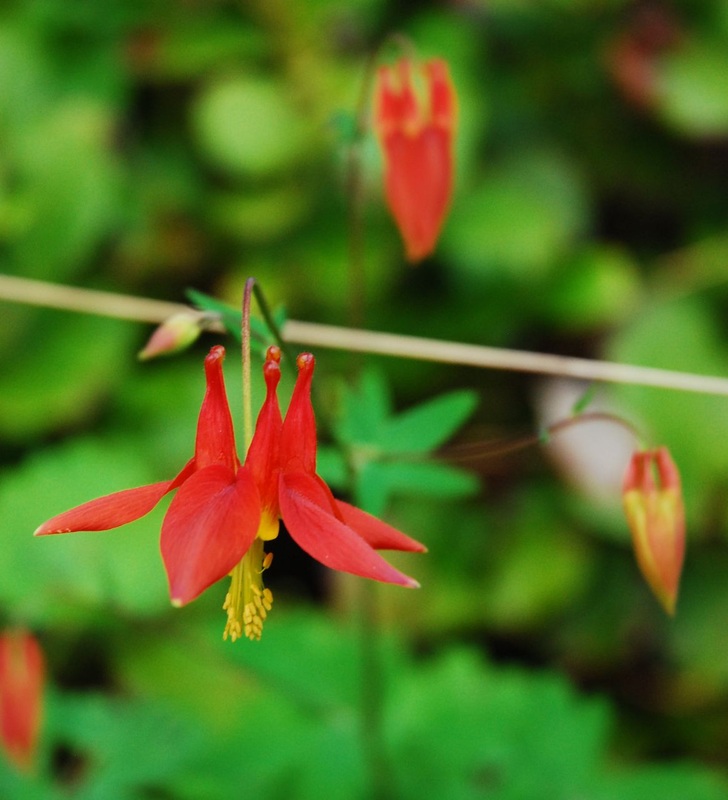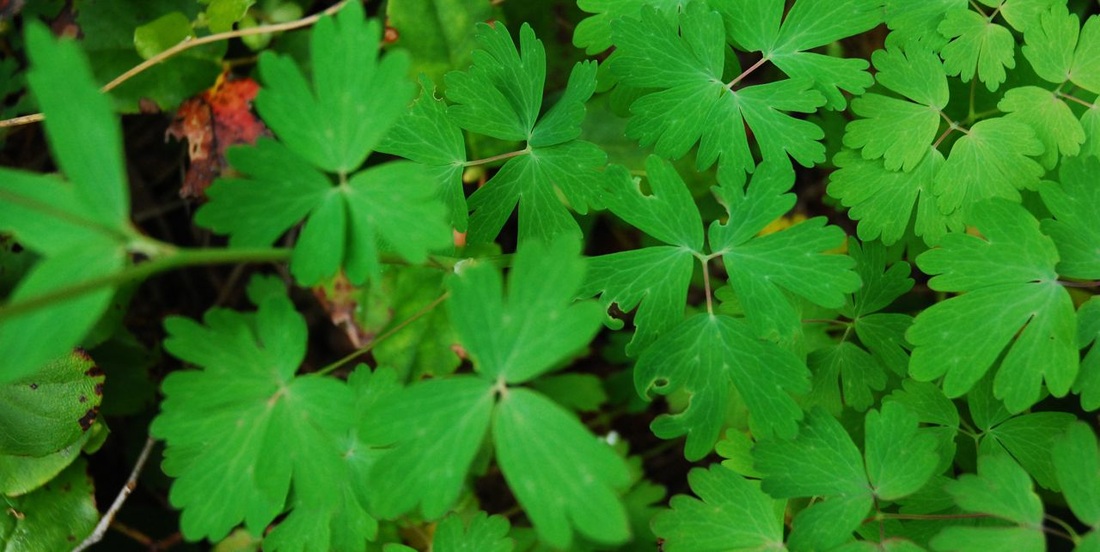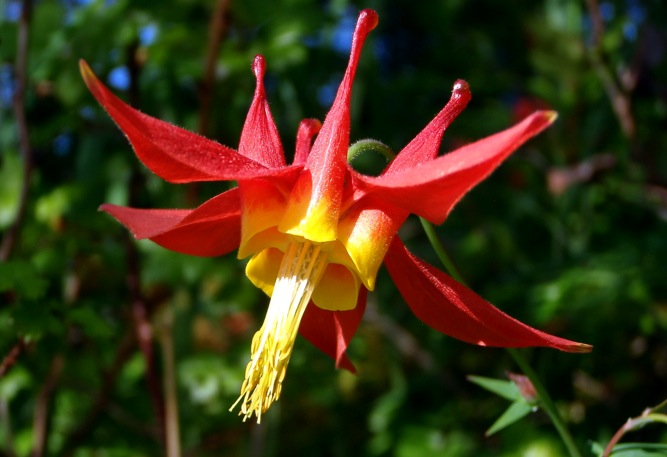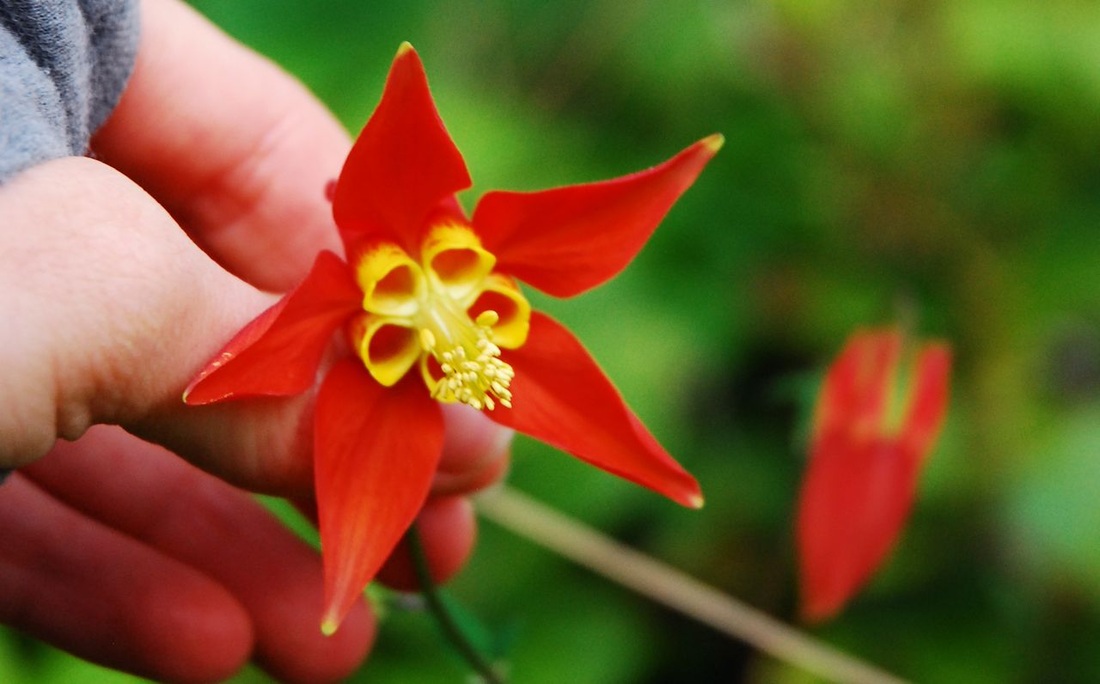Red columbine, narcissus anemone, Sitka columbine • Aquilegia formosa
{Columbine from columbinana = dove-like}
Red columbine growing on Calvert Island. Photos by Teegan Bennington (top right) and Kelly Fretwell. Red columbine leaves are shown in the bottom left photo.
Identification
This perennial flower grows to 1 m tall on unbranched, upright stems. The eye-catching red and yellow flowers hang down from the drooping stem-tops, and are composed of 5 distinct red petals with upright red spurs. A central stamen tuft attaches to the middle yellow part of the flower. Flowers are 2-5 cm wide, and there are usually 2-5 flowers in a branching cluster on each stem (inflorescence). Leaves are mostly basal, and divide into threes two times (resulting in 9 leaflets). They are 10-40 cm long, with long stalks. The leaflets are deeply lobed, and distinctly separated. They are usually hairy, and are a bright green above and paler underneath.
Habitat & Range
This species is commonly found from lowlands up to the tree line; it is not usually inhabit alpine elevations. It grows in moist, nitrogen-rich soils in open or partially shaded areas such as meadows, shorelines, forest clearings, roadsides, thickets, and rocky slopes. It is a common species in most of BC, and is found throughout western North America from Alaska to California, and east to Utah, Wyoming, and southwestern Alberta (click here for range map).
Similar Species
The leaves of red columbine look similar to those of western meadowrue. The lobes of red columbine leaves are more separate than western meadowrue leaves.
Human Uses
When scraped, the roots yield a milky substance. A traditional poultice from the Quileute First Nation was made from this substance combined with chewed red columbine leaves; this was put on sores to encourage healing. Throughout North America other traditional First Nations uses of this plant include treatment of diarrhea, dizziness, joint pain, and potentially venereal disease.
iNaturalist
https://www.inaturalist.org/taxa/48244-Aquilegia-formosa
This perennial flower grows to 1 m tall on unbranched, upright stems. The eye-catching red and yellow flowers hang down from the drooping stem-tops, and are composed of 5 distinct red petals with upright red spurs. A central stamen tuft attaches to the middle yellow part of the flower. Flowers are 2-5 cm wide, and there are usually 2-5 flowers in a branching cluster on each stem (inflorescence). Leaves are mostly basal, and divide into threes two times (resulting in 9 leaflets). They are 10-40 cm long, with long stalks. The leaflets are deeply lobed, and distinctly separated. They are usually hairy, and are a bright green above and paler underneath.
Habitat & Range
This species is commonly found from lowlands up to the tree line; it is not usually inhabit alpine elevations. It grows in moist, nitrogen-rich soils in open or partially shaded areas such as meadows, shorelines, forest clearings, roadsides, thickets, and rocky slopes. It is a common species in most of BC, and is found throughout western North America from Alaska to California, and east to Utah, Wyoming, and southwestern Alberta (click here for range map).
Similar Species
The leaves of red columbine look similar to those of western meadowrue. The lobes of red columbine leaves are more separate than western meadowrue leaves.
Human Uses
When scraped, the roots yield a milky substance. A traditional poultice from the Quileute First Nation was made from this substance combined with chewed red columbine leaves; this was put on sores to encourage healing. Throughout North America other traditional First Nations uses of this plant include treatment of diarrhea, dizziness, joint pain, and potentially venereal disease.
iNaturalist
https://www.inaturalist.org/taxa/48244-Aquilegia-formosa
References
Aquilegia formosa Fisch. ex DC. In Klinkenberg, Brian. (Ed.). E-Flora BC: Electronic Atlas of the Plants of British Columbia. Lab for Advanced Spatial Analysis, Department of Geography, University of British Columbia, Vancouver. Accessed 12/08/2013.
Aquilegia formosa Fisch. ex DC., western columbine. USDA Plants Database. Accessed 12/08/2013.
Pojar, J. and MacKinnon, A. (1994). Plants of Coastal British Columbia. Vancouver, BC: Lone Pine Publishing. P. 180.
Authors and editors of page
Kelly Fretwell and Brian Starzomski (2013).
Aquilegia formosa Fisch. ex DC. In Klinkenberg, Brian. (Ed.). E-Flora BC: Electronic Atlas of the Plants of British Columbia. Lab for Advanced Spatial Analysis, Department of Geography, University of British Columbia, Vancouver. Accessed 12/08/2013.
Aquilegia formosa Fisch. ex DC., western columbine. USDA Plants Database. Accessed 12/08/2013.
Pojar, J. and MacKinnon, A. (1994). Plants of Coastal British Columbia. Vancouver, BC: Lone Pine Publishing. P. 180.
Authors and editors of page
Kelly Fretwell and Brian Starzomski (2013).








